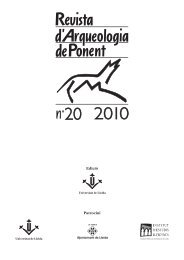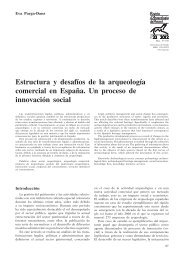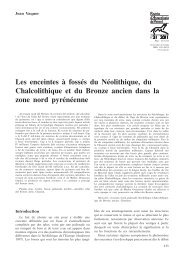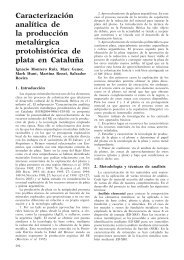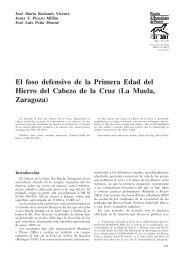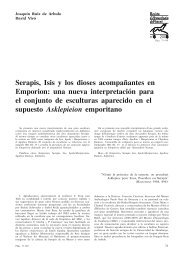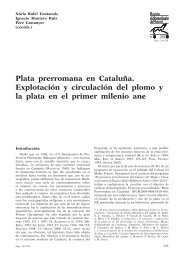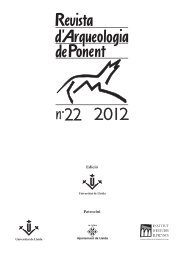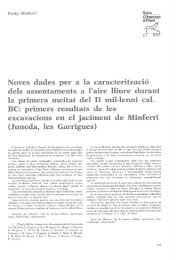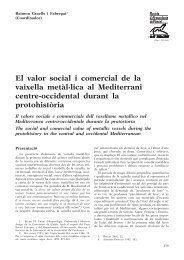RAP 18.1.indd - Revista d'Arqueologia de Ponent
RAP 18.1.indd - Revista d'Arqueologia de Ponent
RAP 18.1.indd - Revista d'Arqueologia de Ponent
You also want an ePaper? Increase the reach of your titles
YUMPU automatically turns print PDFs into web optimized ePapers that Google loves.
Juan Carlos GuixPàgs. 139-145Iron, fire and sheep: their effectson the Holocene expansion of openvegetation in the Iberian PeninsulaLa dispersió <strong>de</strong> llavors per ovelles, cabres i gossos domèstics vaser estudiada en tres ramats en el municipi d’Abrera, situat a laprovíncia <strong>de</strong> Barcelona, al nord-est <strong>de</strong> la península Ibèrica. S’hi vatrobar un total <strong>de</strong> 3.267 llavors i altres estructures reproductorespertanyents a 37 espècies <strong>de</strong> plantes herbàcies i gramínies adheri<strong>de</strong>sal pelatge <strong>de</strong> les ovelles, els gossos i a la roba <strong>de</strong>ls pastors. Diverses<strong>de</strong> les espècies <strong>de</strong> plantes dispersa<strong>de</strong>s pels ramats d’ovelles es trobenàmpliament reparti<strong>de</strong>s en hàbitats <strong>de</strong> tipus obert a Euràsia. Lesda<strong>de</strong>s recolli<strong>de</strong>s suggereixen que la dispersió <strong>de</strong> llavors associada alsramats d’ovelles ha contribuït, <strong>de</strong> forma significativa, a l’expansió <strong>de</strong>les àrees <strong>de</strong> distribució <strong>de</strong> diverses espècies <strong>de</strong> plantes herbàcies igramínies, <strong>de</strong> l’est a l’oest d’Europa i possiblement també entre elnord d’Àfrica i el sud d’Europa. La <strong>de</strong>sforestació, a llarga escala, iels incendis produïts en la península Ibèrica entre 2.400 i 1.500 anysenrere, així com també la dispersió <strong>de</strong> llavors per ramats d’ovelles,van ser tres factors importants <strong>de</strong> transformació primerenca <strong>de</strong>lpaisatge silvícola que va propiciar l’aparició <strong>de</strong> formacions vegetalssimilars a les estepàries. Es planteja la hipòtesi que, durant elperío<strong>de</strong> <strong>de</strong> grans interferències antròpiques a la península Ibèrica(entre 2.500 i 50 anys enrere) les formacions <strong>de</strong> tipus esteparivan incorporar diverses espècies <strong>de</strong> plantes proce<strong>de</strong>nts <strong>de</strong> l’estd’Europa, l’Orient mitjà i d’Àsia. Actualment, els ramats d’ovellesencara juguen un important paper en la dispersió <strong>de</strong> llavors tant<strong>de</strong> les espècies arqueòfites com <strong>de</strong> les neòfites.Paraules clau: arqueòfits, epizoocòria, brostejadors, ecologiahistòrica, Ovis aries, transformació <strong>de</strong>l paisatge, sistemes plantaherbívor,dispersió <strong>de</strong> llavors.Seed dispersal by sheep, goats and domestic dogs was studied inthree herds in the municipality of Abrera, located in the province ofBarcelona, Northeastern Iberian Peninsula. A total of 3,267 seeds andother reproductive structures belonging to 37 epizoochoric speciesof herbaceous and gramineous plants were found attached to thefur of sheep and dogs and on the clothing of herdsmen. Severalof these plant species are wi<strong>de</strong>ly distributed in open habitats inEurasia. Data suggest that seed dispersal associated to sheep herdscontributed significantly to the expansion of the distribution areas ofseveral herbaceous and gramineous plant species, from Eastern toWestern Europe and possibly between Northern Africa and SouthernEurope. Large-scale <strong>de</strong>forestations and repeated burnings promotedin the Iberian Peninsula between 2400 and 1500 B.P. as well asseed dispersal performed by domestic sheep were three importantfactors of early landscape transformation from forests to steppelike formations. It is hypothesised that during the period of majoranthropogenic interferences in the Iberian Peninsula (2500 to 50B.P.), the steppe like formations of this region incorporated severalplant species coming from Eastern Europe, the Middle East andAsia. Nowadays, sheep herds still play an important role on seeddispersal of both archaeophyte and neophyte species.Key words: archaeophytes, epizoochory, grazers, historical ecology,Ovis aries, landscape transformation, plant-herbivore systems,seed dispersal.IntroductionAnalyses of palaeopollen data from the Holoceneindicate that many of the currently existing openplant formations in the Iberian Peninsula, such asgrasslands, steppes, heaths and low shrub lands, havemainly resulted from the <strong>de</strong>gradation of woodlandover the past 4,000 years (Bi r k s 1986, Bu r j a c h s 1994,Bu r j a c h s et al. 1997, Ad a m s & Fa u r e 1998, Yl l et al.,Pàgs. 139-1452003). Here I assess archaeological information usingdata on seed dispersal by herds in or<strong>de</strong>r to investigatethe mechanisms involved in the <strong>de</strong>gradation ofwoodland towards steppe-like stages.A case study in AbreraBetween March 2001 and October 2006, seeddispersal by sheep (Ovis aries), domestic goats (Ca-139



